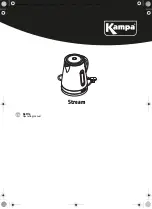
INSTALLATION
WARNING: PLUMBING CONNECTIONS MUST
COMPLY WITH APPLICABLE
HEALTH, SAFETY AND PLUMBING
CODES.
A. Select a location to provide drainage directly below
the draw-off valve (optional). Allow sufficient rear
clearance from the wall for the kettle cover to lift
upright freely without obstructions.
B. Mark anchoring hole locations through flanged
adjustable feet (VDLT models), or holes in the
pedestal base (VDPT models).
C. With hole locations marked, drill holes and insert
expansion plugs to accommodate 5/16" size lag
bolts.
D. Reposition the kettle. On VDLT models level the
kettle by making necessary adjustments using the
flanged feet.
E. Bolt the kettle down and seal with a high grade
sealing compound. Sealant must be applied not
only to bolt heads but around the flanges or pedes-
tal base and must be making contact with floor
surface to meet N.S.F. requirements. Wipe off
excess sealant immediately.
F. Connect steam line (
3
/4" pipe size) to the kettle,
making sure there is a steam control valve
strainer (not supplied) fairly convenient to the
kettle.
G. Connect the kettle condensate return line to a
drain or to a boiler return line. Each kettle return
line must have a suitable steam trap (not
supplied). Boiler return lines must have a check
valve (not supplied).
H.
The relief valve on the kettle must not be adjusted
or closed off as it is set to relieve excess pressure
in the kettle.
I.
If the incoming steam pressure is greater than
kettle
maximum operating pressure,
then a
pressure reducing valve (not supplied)
must
be
installed in the line.
J. If large amounts of water accumulate in the steam
line, it will be necessary to install one or more ball
float traps (not supplied) in the line to eliminate
the water.
K.
A steam line pressure gauge (not supplied) is
also recommended to determine the actual
amount of steam coming to the kettle.
L.
Turn unit "ON" and check for proper operation.
5































